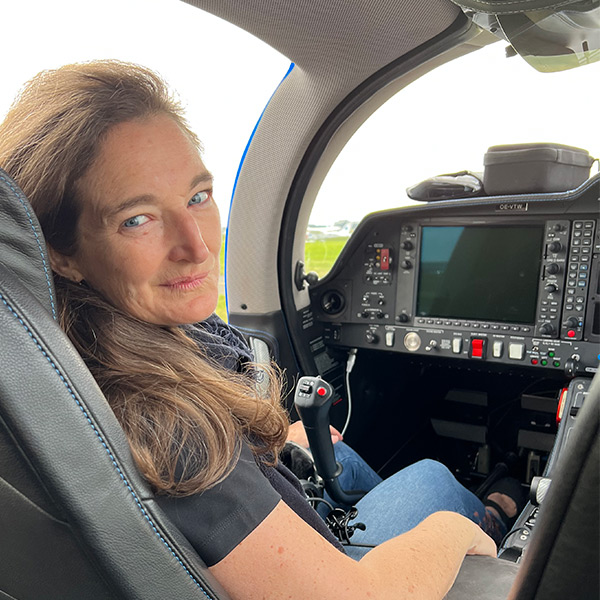When she was a little girl, the sky had always fascinated her. "I used to memorize the names of the stars," she says. She remembers staying up into the early morning to watch for a lunar eclipse, and being so awestruck that she woke up her family. "I woke up the neighbors, too. 'Look! Look!' No one was as excited as I was."
In China, general aviation is practically nonexistent. When Ni was growing up, a person's only chance to fly was to become an army pilot. One can't join the army unless he (or she) is trusted by the Communist Party, and, because Ni's family was out of favor, it would have been impossible for her to get an army slot. So she put aside her dreams, until after college and her move to the United States.
Ni earned a bachelor's of science from Nanjing University and, studying in Bejing, earned the equivalent of a master's degree. After she had worked in China with American scientists, they invited her to continue working with them in the United States. Six years ago she moved to Boulder, Colorado, and got a position with the National Oceanic and Atmospheric Administration (NOAA), where she researches the effects of greenhouse gases and their distribution in the atmosphere.
Three years back she began working on a project that gathers air samples from light aircraft. Under contract, a local FBO loads NOAA's equipment in a turbocharged Cessna 182 or 210 and climbs to a published intersection at a specific altitude, between FL 180 and 280 (18,000 to 28,000 feet) depending on the aircraft used. The pilot then enters a descending holding pattern and takes one air sample every 1,000 feet until reaching 7,000 feet.
These air sampling missions last about two hours, and Ni hopped on a few of them as a passenger. The experience re-ignited her desire to fly, and she began her training in early 1996. But the path to her private pilot certificate was far from easy. Ni speaks English well, but learning a technical skill - especially one that involves radio communication - in another language was a challenge. She weathered a sudden instructor change and witnessed a mid-air collision that resulted in two fatalities and sent veteran pilots home shaken.
Before that, she had an encounter with a mountain wave. It occurred while she was in the traffic pattern at Boulder, on her second solo, with the wind out of the east at about 10 knots. Within one circuit of the pattern, the wind switched to the west at 25 knots, gusting to 35. She landed in the midst of this wind shift and all its associated turbulence. "I thought the airplane wasn't working right," she says. "It was a clear sky, and I didn't have enough experience to know it was the weather causing the turbulence." Ni landed successfully and nearly took off again, but in an instant, she thought it better of it and taxied back in.
A few weeks later, she witnessed an accident that sent an RV-6 into a lake near the Boulder airport and a glider to the runway without a wingtip. She called 911 for help as two instructors dashed out to the lake. She thought hard about quitting and did some hiking in the nearby mountains to gain perspective.
"I never thought I'd be as scared as I was after the wind shift encounter," she says. "But now, I don't think anything negative. It was a good experience, though I don't want to do it again." Ni says nothing about the midair collision.
In the end, she stuck to it and earned her private certificate in the fall of 1996. "Flying was the dream in my soul," she says. "To see like a bird ... to have the freedom."
Ni wanted to do something fun with her new ticket. Looking into graduate school at the time, she decided to fly to California and look at a school in Santa Barbara first. Her instructor flew with her, but Lucky stayed home, "because you can't get a hotel as easily with a dog."
The flight out took them over some of the most spectacular scenery in the country - the Rocky Mountains, the Grand Canyon, and Lake Powell. The trip was capped by an instrument approach into Santa Barbara Municipal.
The thick marine layer "looked so interesting under the blue sky and the golden sunshine," Ni says. "I had a strange but very wonderful feeling when we sank into the sea of clouds, slowly and quietly." She's since decided that California is the place she'd like to go for graduate school.
A vacuum system failure while taxiing to the runway delayed their departure two days. They landed at Page, Arizona, around 8 p.m. "The whole desert was pink. It was like landing on Mars!" Ni says. The moon was full that evening. It was the night of the Mid-Autumn Festival, one of China's biggest holidays. "We took off again from Page, and the moon was just rising ... it soon climbed up above us. The moon was flying with me! I felt as though I could reach her with my hands."
Ni's flying plans involve her instrument rating, and, eventually, her flight instructor certificate. She's also ready to see more of the United States from the cockpit. Returning to China, however, may not be in the cards. A future in aviation would be difficult for her to pursue there.
Flying over the American West, she found the hook that will keep her flying, no matter what. "Those white, pink, and golden-colored clouds, floating around the green and purple mountain peaks - I thought I was in some wonderland." And she was. She was flying.



